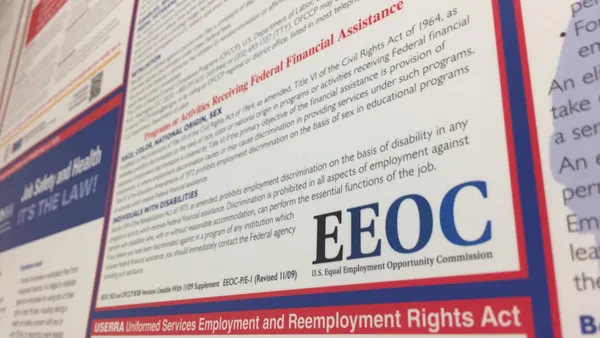Dive Brief:
- President Donald Trump touched on a number of workforce issues during his second State of the Union address Tuesday night, devoting most mentions to job creation and low unemployment. The president also spoke of his deregulation successes, saying the moves have encouraged employers to return to the U.S.
- Trump noted the early jobs numbers for January, as well as the near record-low unemployment rate. He also called attention to the increased employment of racial minorities and workers with disabilities, but said "no one has benefited more from our thriving economy than women, who have filled 58% of the new jobs created in the last year." Trump also said that wages are rising at the fastest pace in decades. While wages are increasing slightly, "real wage" numbers, which account for inflation, haven’t trended upward, according to recent data.
- The president touted a nationwide paid family leave program "so that every new parent has the chance to bond with their newborn child" as well as an immigration system "that is safe, lawful, modern and secure."
Dive Insight:
Trump's comments largely tracked previous campaign promises and talking points.
He spoke of "defending American jobs" — no surprise after his "buy American, hire American" mandate. But Trump's immigration talk also has softened in recent weeks; he began discussing ways to allow high-skilled workers into the country and shortly thereafter his U.S. Department of Homeland Security reversed its H-1B lottery system to prioritize workers with a master's or higher degree from a U.S. institution. He continued this sentiment in his speech, saying "I want people to come into our country in the largest numbers ever, but they have to come in legally."
Trump's statements on unemployment also were to be expected; the number of those without jobs ticked up slightly in January to 4% but the U.S. Bureau of Labor Statistics noted that the number may be inflated by those furloughed during the federal government shutdown.
Despite low unemployment and job creation, wages still haven't seen much movement, which economists say they would have expected. U.S. wages grew 3.5% over the last year, increasing U.S. average pay by 95 cents to $27.81 an hour in 2018, according to ADP's Workforce Vitality Report. But when accounting for inflation, wages actually declined, falling by 1.3% since the end of 2017, according to Payscale. Trump said in his speech that "wages are rising at the fastest pace in decades, and growing for blue collar workers, who I promised to fight for, faster than anyone else." But according to Payscale, wages for blue-collar workers have been hit the hardest.
Trump also highlighted his numerous successes in rolling back federal regulations that many businesses found burdensome. Employers have generally favored these moves, but also have noted the regulatory back-and-forth that now occurs with every administration change is creating significant compliance costs. Additionally, experts say the administration's efforts — along with congressional stalemates — have spurred states to pick up the slack, increasingly adopting minimum wage, ban-the-box, paid leave and other laws.
Even Trump’s passing mention of paid leave wasn't unprecedented. The initiative was featured in his campaign promises and appeared in his fiscal year 2019 budget proposal. That plan, however, drew criticism for its focus on parents. It's unclear whether a new plan would include other uses, such as those contemplated by the Family and Medical Leave Act. It's also unclear how such a benefit would be funded; Trump previously said the country could fund it through a crackdown on unemployment fraud, but Ivanka Trump has since backed a bill that would allow new parents to pull forward a portion of their Social Security.











